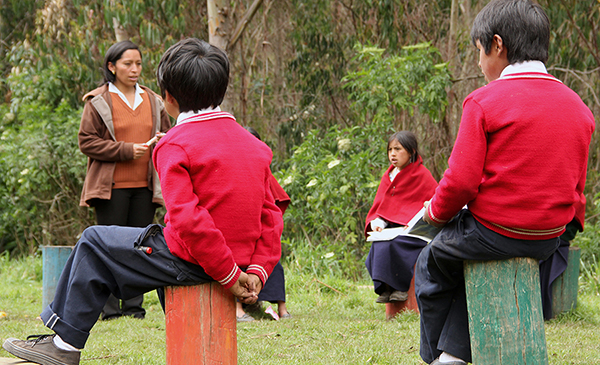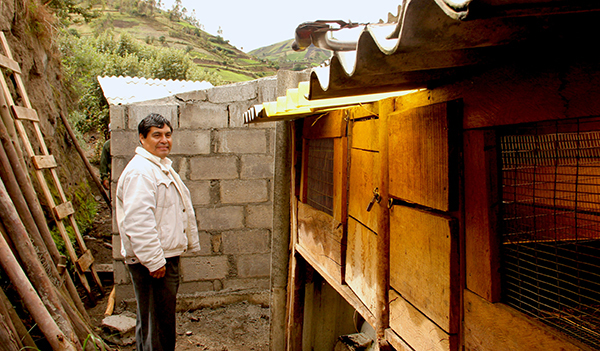The road goes from pavement to cobblestone, to dirt. Small tin-roofed houses reveal themselves, hidden high in the hills. They can only be found by following the trail of concrete steps coated in a fine veil of green moss from the street to their doors.
Dr. Antonio Tayupanda, director of Columbe Lote 1 y 2 greets us in front.
He leads us to four young male volunteers energetically sloshing together cement in a wheelbarrow and hammering apart the adjoining wall of the old, insufficient bathrooms. Currently, there are five bathroom stalls for the 170 students who attend the school. A long basin of dirtied pink and while tile with brass faucets serves as a sink. They are constructing three more bathroom stalls through funding by MEDLIFE Ecuador.
Dr. Tayupanda surveys the work proudly. This new project will serve his students, who range from ages four to 16 years old, well. He is stocky and his posture is straight. Brown eyes framed by crinkles of smile lines nestle into his round face. For a 48-year-old man, his hair is youthful. A thick black curl falls in the center of his forehead.
After snapping photos of troweling out thick cement mixtures and aligning cinderblock bathroom walls, the director insists on feeding us. He whisks us away to a small classroom where we squeeze into wooden chairs better suited for five-year-olds. Dr. Tayupanda leans in the doorway, pressing us to finish our plates like a worried mother. He is bundled in a white corduroy coat with a faux-sheepskin collar, though the weather is warm. Small children in thick, red wool sweaters danced about his feet, excited by visitors and the day’s construction. He playfully pats them all on the head.
Our next stop is a bare classroom. A thick red curtain serves as a separating wall for the long room. It hangs limply and unevenly on a wire strung across the ceiling. Dr. Tayupanda speaks of the dire need for more schoolhouses, gesturing out of a dirtied window lined with small potted plants.
Outside was a circle of painted wooden stumps that served as the student’s seats. They conduct class here when they run out of room indoors. The strong winds turn the pages of Quichua instruction books, and teachers, of which there are 12 in the school, have to compete with the loud moos of cows grazing in the distance. The lack of space is a thorn in his side as principal. This is one of only three stark classrooms they have at the school. But smoke hangs in the air. Why?
The director answers our questions with a gesture toward the back of the classroom. There lies a narrow room the size of a closet. Three young women in traditional dress cluster around a fire, heating a large metal pot of potatoes. They peel potatoes with small knives, and chatter, and lean toward the one open window for fresh air. They were making lunch for the students, and the principal was proud that no one went hungry here.
Dr. Tayupanda excitedly leads us to the back of the school’s property. It appears that lunch was not only provided for each student, for the cost of one U.S. dollar per month, but it was home-grown.
We slip through a narrow, muddy passageway between a schoolhouse and a small set of three cages formerly used to raise guinea pigs. Here lays his pet project to improve the school — a cinderblock foundation of what will be a new, larger pen for guinea pig farming.
Though not what one assumes of school lunch, guinea pig is a common dietary supplement in the rural communities of Ecuador. According to the Telegraph, these small rodents can have “more protein and less cholesterol than beef, pork, lamb or chicken.” They’re also quite easy to raise, needing a few servings of commonly grown vegetables a day, such as dark greens, radishes and celery.
Around the corner from the pen are steep hills of fertile, black earth. Dr. Tayupanda points to our feet where a springy lettuce plant grows.
“In three months, it’s ready to be harvested,” he says, beaming.
The hills surrounding the school are draped with rectangular plots of vegetables. Blackberry vines curl along the thin wooden fence surrounding the farm plots. Crops like potatoes, onions, cilantro, turnips, and peppers are grown by the parents of the children on these hills. They volunteer once a week, and the harvest feeds the children and teachers lunch throughout the year.
“How long have you worked here?” I then ask.
“Twenty three years,” he replies without a blink. “And you, you’re what? Twenty-two?” he asks smiling.
“Yes, twenty-two, how did you know?”
He let out a deep laugh. “Twenty three years working [with young people] and I know a twenty-two-year-old.”
He thanks us for visiting, shaking our hands with both of his.
I really hope that you return and come see us,” he says sincerely, as if inviting us back for a family dinner.
Rachel Hoffman is a MEDLIFE media intern based in Riobamba, Ecuador


